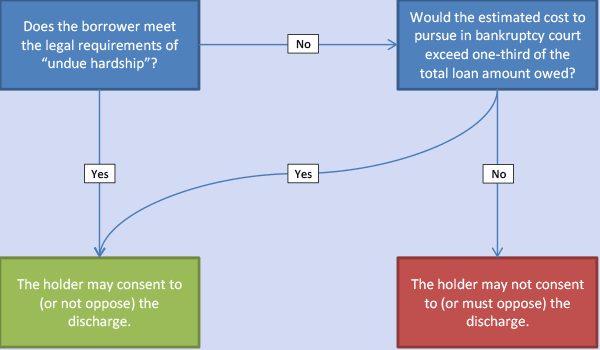Student Loans Can Be Discharged in Bankruptcy, But It’s Not Easy
By Mandy Sponholtz, Policy & Federal Relations Staff
Students may seek to have their loans discharged in bankruptcy court, but must prove that repaying the loan poses an “undue hardship.” The Department of Education (ED) published a 23-page Dear Colleague Letter outlining the provisions to which loan holders must adhere when evaluating a borrower’s request. While ED directs this guidance at schools that hold Perkins loans and Federal Family Education Loan holders, it also follows the same process when evaluating loan discharge requests for Direct Loans.
The process loan holders must follow contains two steps:
- Evaluate a borrower’s undue hardship claim against legal standards set by Federal courts.
- If the holder determines an undue hardship does not exist, evaluate the cost of objecting to the discharge request in court.
The DCL primarily addresses the first step and expands regulations contained in §682.402(i) and §674.49.
Step 1: Evaluate the Borrower’s Claim
The Bankruptcy Code does not define “undue hardship,” and ED relies on extensive case law to determine the criteria for undue hardship. Generally speaking, courts use one of two tests to evaluate undue hardship, with the burden of proof resting with the borrower. ED requires loan holders to evaluate the undue hardship claim using these legal standards, but does not specify how the holder must use these tests.
The criteria of the two tests are:
Brunner Test |
Totality of the Circumstances Test |
|---|---|
|
A borrower must demonstrate all of the following:
|
The court examines all of the following:
|
Step 2: Evaluate the Cost of Objecting the Discharge Request in Court
Step two only occurs if the loan holder determines that the borrower does not have undue hardship. This cost/benefit analysis requires holders to estimate the cost of litigating the bankruptcy request in court versus the borrower’s total outstanding loan balance, which includes current principal, unpaid accrued interest and current, unpaid accrued collection costs. If the estimated costs exceed one-third of the total amount owed, then the loan holder may consent to (or not oppose) the discharge request.
Summary of the 2-Step Process
Judgment Authority and Support
While ED acknowledges the loan holder’s authority to assess undue hardship, ED may review the results of the determination through an audit or program review. Loan holders must document all bankruptcy decisions. ED provides personnel to loan holders to discuss bankruptcy applications to help avoid potential adverse findings.
The Dear Colleague Letter provides sample factors to consider when making determinations of undue hardship, along with example case studies and analyses of bankruptcy applications. We recommend involving your legal counsel in bankruptcy determinations. The letter also provides a vast amount of background legislative, circuit court and regulatory information that would be beneficial to share with legal counsel.
Publication Date: 7/9/2015






You must be logged in to comment on this page.